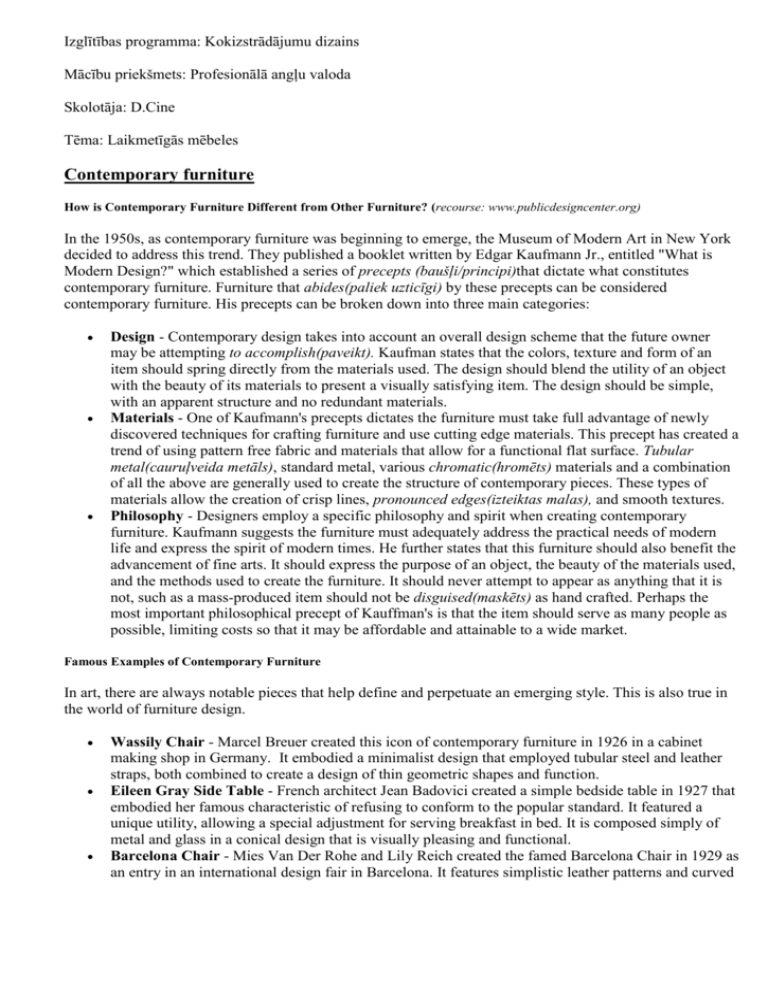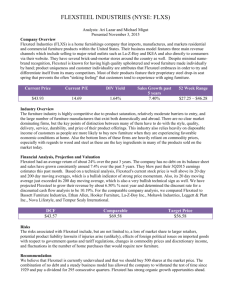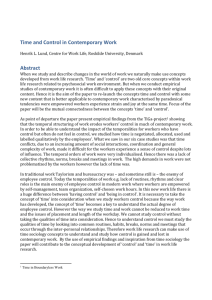Mēbeļu-dizains-laikmetigās-mēbeles.Contemporary
advertisement

Izglītības programma: Kokizstrādājumu dizains Mācību priekšmets: Profesionālā angļu valoda Skolotāja: D.Cine Tēma: Laikmetīgās mēbeles Contemporary furniture How is Contemporary Furniture Different from Other Furniture? (recourse: www.publicdesigncenter.org) In the 1950s, as contemporary furniture was beginning to emerge, the Museum of Modern Art in New York decided to address this trend. They published a booklet written by Edgar Kaufmann Jr., entitled "What is Modern Design?" which established a series of precepts (baušļi/principi)that dictate what constitutes contemporary furniture. Furniture that abides(paliek uzticīgi) by these precepts can be considered contemporary furniture. His precepts can be broken down into three main categories: Design - Contemporary design takes into account an overall design scheme that the future owner may be attempting to accomplish(paveikt). Kaufman states that the colors, texture and form of an item should spring directly from the materials used. The design should blend the utility of an object with the beauty of its materials to present a visually satisfying item. The design should be simple, with an apparent structure and no redundant materials. Materials - One of Kaufmann's precepts dictates the furniture must take full advantage of newly discovered techniques for crafting furniture and use cutting edge materials. This precept has created a trend of using pattern free fabric and materials that allow for a functional flat surface. Tubular metal(cauruļveida metāls), standard metal, various chromatic(hromēts) materials and a combination of all the above are generally used to create the structure of contemporary pieces. These types of materials allow the creation of crisp lines, pronounced edges(izteiktas malas), and smooth textures. Philosophy - Designers employ a specific philosophy and spirit when creating contemporary furniture. Kaufmann suggests the furniture must adequately address the practical needs of modern life and express the spirit of modern times. He further states that this furniture should also benefit the advancement of fine arts. It should express the purpose of an object, the beauty of the materials used, and the methods used to create the furniture. It should never attempt to appear as anything that it is not, such as a mass-produced item should not be disguised(maskēts) as hand crafted. Perhaps the most important philosophical precept of Kauffman's is that the item should serve as many people as possible, limiting costs so that it may be affordable and attainable to a wide market. Famous Examples of Contemporary Furniture In art, there are always notable pieces that help define and perpetuate an emerging style. This is also true in the world of furniture design. Wassily Chair - Marcel Breuer created this icon of contemporary furniture in 1926 in a cabinet making shop in Germany. It embodied a minimalist design that employed tubular steel and leather straps, both combined to create a design of thin geometric shapes and function. Eileen Gray Side Table - French architect Jean Badovici created a simple bedside table in 1927 that embodied her famous characteristic of refusing to conform to the popular standard. It featured a unique utility, allowing a special adjustment for serving breakfast in bed. It is composed simply of metal and glass in a conical design that is visually pleasing and functional. Barcelona Chair - Mies Van Der Rohe and Lily Reich created the famed Barcelona Chair in 1929 as an entry in an international design fair in Barcelona. It features simplistic leather patterns and curved tubular steel to create an aesthetically pleasing chair. The accompanying footstool embodies the Roman numeral for 10 (X) to create its structure. Contemporary Furniture Is… Contemporary furniture is quite simply any type of furniture that uses modern materials with a simplistic design. The function is considered paramount. Creating a visually compelling item is secondary. Contemporary furniture strives to be affordable and attainable. Contemporary: Contemporary combines influences, trends, and new technologies without strict adherence to any one design philosophy. Current trends include designs that blend styles and periods but are streamlined for today’s taste. Contemporary Style Basics: (recourse:www.furniture.about.com) A contemporary style is one that is rooted in today's looks and preferences and does not look beyond the immediate past. The inspiration does not go beyond a century back. The most distinguishing feature is that while it can be either formal or informal, it is never fussy or overwrought. Contemporary style is easily recognizable for its simple and sleek lines. It is very distinguishable from a more traditional style in that there is hardly any intricate detail or carving. The lines of contemporary style furniture are either hard edged or gently curved. Finishes can be in all tones, from very light to dark. Traditional and non traditional materials are used, and often combined, and new concepts and materials are explored. Just as the term "traditional style" covers a great number of different styles, so does the term "contemporary style". Some different contemporary styles Urban: Urban furniture is designed for city-dwellers with smaller living spaces. For that reason pieces tend be smaller in scale, but sophisticated and well designed. While small in size, they can be very high in impact. Urban style is defined by Striking lines and shapes Very little ornamentation Black along with a range of bright or primary colors A range of materials such as metal, light wood, glass, leather and microfiber Retro: Retro is a whimsical look at recently bygone eras from the 1950s to the 1980s. What is termed retro today was fashionably modern when it first came out. This type of furniture has now come out from the recesses of garages and basements, and graces many modern homes. One piece modular plastic chairs Formica-topped tables, chrome bar stools, furniture reminiscent of 1950s diners Boomerang tables and space-age / Sputnik style Items with kitschy, pop culture flavor Art Deco: Art Deco furniture is defined by elegant lines and curves without any of the intricate carvings of traditional furniture. A unique style was created using luxurious materials with synthetic ones and as a result the look is not overly formal. Exotic leathers, silver and gold leaf, mother-of-pearl, ivory and lacquers mixed with relatively cheap contemporary metals, glass, mirrors, synthetic plastics and resins. Elegant and streamlined Light finishes and lacquer, medium toned woods Mirrored and chromed surfaces Mid-Century Modern: Stark and simple designs that are almost sculptural in quality, define the mid-century modern style. Some famous names associated with this style are designers like Ray and Charles Eames, George Nelson and Saarinen. The defining characteristics that capture the essence of this style are Form follows function Little or no ornamentation, with uncluttered and sleek lines Use of traditional material, such as wood, and non-traditional materials such as metal, glass, vinyl, plywood, Plexiglass and Lucite Juxtaposing materials to explore texture A vast range of color, from neutral to bold, including black and white Casual Contemporary: Casual contemporary is a relaxed, softer, updated style that does not have the hard edges of the more formal mid-century modern style. Sometimes the scale can be a bit larger than other contemporary styles. It is quite neutral in looks, and which accounts for its popularity. Rounded and eased edges Medium wood tones, glass, and leather with a range of textures in fabrics Soft or overstuffed surfaces and pillow tops on sofas






